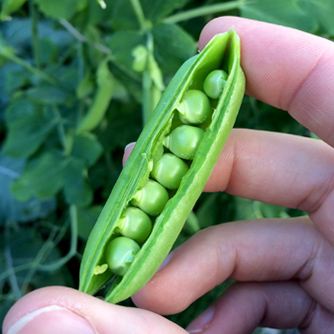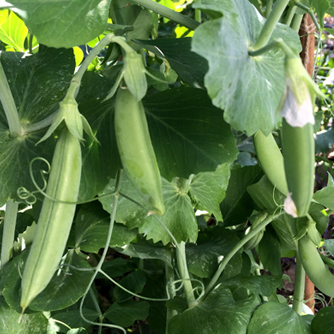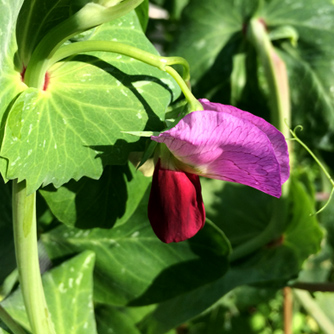Peas
BackPeas are one the oldest veggies to be grown on earth and have been found dating back as far as 9750BC. They were also part of the First Fleet cargo with every convict and marine alike being given a weekly ration of 3 pints of peas!
They are excellent for small yards and balconies as they can be planted in containers and grow vertically without taking up a lot of room. If you are really limited for space try planting half a dozen dwarf pea seeds in a hanging basket – it will certainly make it easy for pickings!
Peas are also great for kids to try because they’re so easy to grow but be warned: you’ll be lucky to cook any as they are so nice to pick and eat straight from the bush!
There are many different pea varieties including snow peas and sugar snap peas which be can eaten whole without the need to shell them first. The good news is that all pea types need the same basic growing conditions which we’ve outlined below.

Tasty peas
How To Grow Peas
Peas are pretty easily pleased and can grow in many different types of soil as long as they have good drainage and plenty of sunshine. Apply dolomite or lime to the soil before planting to provide a good source of calcium and to keep the soil slightly alkaline.
Normally peas are grown from seed and sown directly into the soil when soil temperatures have cooled. Water in seeds after planting and do not water again until the first sprouts poke through (unless the soil gets extremely dry). Initially seeds will absorb all the moisture they need from that first watering and excess watering will cause them to rot. Seedling emerge 1-2 weeks later with harvesting possible 10-14 weeks after that depending on the variety.
Climbing peas require a support structure so grow near a wire fence or use a trellis. Alternatively, tie together some bamboo stakes to form a type of tepee. Be sure to do this before sowing seeds so you don’t damage the roots of emerging seedlings.
Check your plants regularly so that peas are picked at an early stage to ensure they are sweet and not left on the bush to age when the flavour deteriorates.

Sugar snap peas
Sowing Guide for Peas
Being a cool season crop they can be planted anytime from autumn through to spring, depending on your climate:
| Growing Zone | Sowing Time |
| Cool Zones | Autumn, Winter, Spring |
| Mediterranean Zones | Autumn, Winter |
| Warm & Temperate Frost Free Zones | Autumn, Winter |
| Subtropical Zones | Autumn, Winter (Dry Season) |
| Tropical Zones | Not recommended |
The above is a general guide and there are a few other factors to consider when determining sowing time to ensure optimum success.
- Pea seed requires cool soils to germinate (under 20 degrees) which is why they are commonly planted in autumn. However germination time slows down dramatically when frosts start and soils get really cold. Winter plantings in cold areas can often fail because of this as the seed is over watered and rots before germination occurs.
- Frost can damage young seedlings and flowers.
- Hot summer weather promotes stress and powdery mildew. Pod development is also reduced. Generally only areas with very mild summers can grow successful summer crops.
- Tropical regions are generally too hot and humid for much success with peas. In some subtropical areas they can also be tricky.
Fertilising
Peas, like all legumes, have a special ability to use nitrogen fixing bacteria in their roots which absorb additional nitrogen from the air. So unlike most veggies they don’t need as much nitrogen-based fertiliser. In fact if you give them too much nitrogen it often results in lots of growth but few flowers. If you have poor soil then add some cow manure or compost at sowing time but otherwise leave it be. An application of dolomite or lime is all we recommend to get them started.
Once seeds have sprouted apply a mixture of OCP eco-seaweed and OCP eco-aminogro approximately every 3 weeks to the soil (or as a foliar spray) to produce a fabulous crop. Easy peasy!
Pests and Diseases for Peas
- Watch out for snails and slugs which especially like the new shoots as they emerge from the soil. Apply OCP eco-shield to protect the seedlings.
- Aphids and mites can be a problem but can be controlled with organic insecticides. With mites in particular act quickly to prevent numbers exploding.
- Fungal diseases like powdery mildew are also common especially late in the season or when conditions are damp with poor circulation around plants. Increase airflow around plants and minimise overhead watering to keep the foliage dry. Spray with an organic fungicide if needed.
- Root damage caused by parasitic nematodes is something to suspect if you have plants which are underperforming (stunted growth, yellowing leaves and wilting) for no obvious reason. Treat the soil with OCP eco-nemguard.
In general, good plant hygiene is important so remove old and dead leaves and clear away weeds as these provide ideal conditions for many pests and diseases to thrive. Practice crop rotation to prevent problems occurring.
Other problems
Poor germination – usually due to over watering before seeds have time to germinate or incorrect soil temperature (too hot or too cold).
No Flowers – too much nitrogen rich fertiliser was applied.
Flowers but no pods develop – can be due to poor pollination (encourage bees by planting more flowering plants), frost damage or regular hot weather causing flower failure.

Snow pea flower


